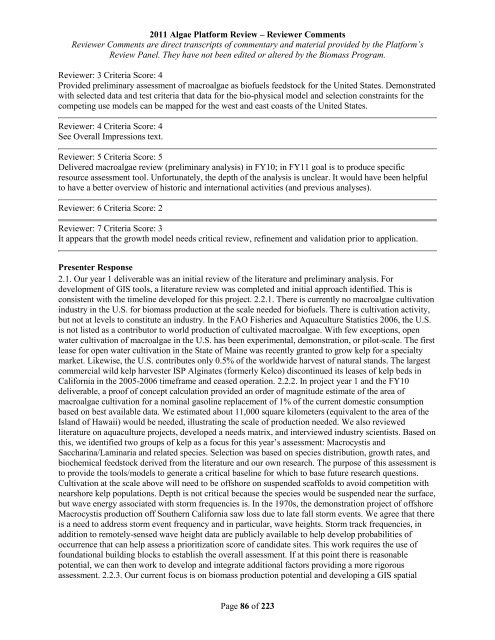Reviewer Comments - EERE
Reviewer Comments - EERE
Reviewer Comments - EERE
You also want an ePaper? Increase the reach of your titles
YUMPU automatically turns print PDFs into web optimized ePapers that Google loves.
2011 Algae Platform Review – <strong>Reviewer</strong> <strong>Comments</strong><br />
<strong>Reviewer</strong> <strong>Comments</strong> are direct transcripts of commentary and material provided by the Platform’s<br />
Review Panel. They have not been edited or altered by the Biomass Program.<br />
<strong>Reviewer</strong>: 3 Criteria Score: 4<br />
Provided preliminary assessment of macroalgae as biofuels feedstock for the United States. Demonstrated<br />
with selected data and test criteria that data for the bio-physical model and selection constraints for the<br />
competing use models can be mapped for the west and east coasts of the United States.<br />
<strong>Reviewer</strong>: 4 Criteria Score: 4<br />
See Overall Impressions text.<br />
<strong>Reviewer</strong>: 5 Criteria Score: 5<br />
Delivered macroalgae review (preliminary analysis) in FY10; in FY11 goal is to produce specific<br />
resource assessment tool. Unfortunately, the depth of the analysis is unclear. It would have been helpful<br />
to have a better overview of historic and international activities (and previous analyses).<br />
<strong>Reviewer</strong>: 6 Criteria Score: 2<br />
<strong>Reviewer</strong>: 7 Criteria Score: 3<br />
It appears that the growth model needs critical review, refinement and validation prior to application.<br />
Presenter Response<br />
2.1. Our year 1 deliverable was an initial review of the literature and preliminary analysis. For<br />
development of GIS tools, a literature review was completed and initial approach identified. This is<br />
consistent with the timeline developed for this project. 2.2.1. There is currently no macroalgae cultivation<br />
industry in the U.S. for biomass production at the scale needed for biofuels. There is cultivation activity,<br />
but not at levels to constitute an industry. In the FAO Fisheries and Aquaculture Statistics 2006, the U.S.<br />
is not listed as a contributor to world production of cultivated macroalgae. With few exceptions, open<br />
water cultivation of macroalgae in the U.S. has been experimental, demonstration, or pilot-scale. The first<br />
lease for open water cultivation in the State of Maine was recently granted to grow kelp for a specialty<br />
market. Likewise, the U.S. contributes only 0.5% of the worldwide harvest of natural stands. The largest<br />
commercial wild kelp harvester ISP Alginates (formerly Kelco) discontinued its leases of kelp beds in<br />
California in the 2005-2006 timeframe and ceased operation. 2.2.2. In project year 1 and the FY10<br />
deliverable, a proof of concept calculation provided an order of magnitude estimate of the area of<br />
macroalgae cultivation for a nominal gasoline replacement of 1% of the current domestic consumption<br />
based on best available data. We estimated about 11,000 square kilometers (equivalent to the area of the<br />
Island of Hawaii) would be needed, illustrating the scale of production needed. We also reviewed<br />
literature on aquaculture projects, developed a needs matrix, and interviewed industry scientists. Based on<br />
this, we identified two groups of kelp as a focus for this year’s assessment: Macrocystis and<br />
Saccharina/Laminaria and related species. Selection was based on species distribution, growth rates, and<br />
biochemical feedstock derived from the literature and our own research. The purpose of this assessment is<br />
to provide the tools/models to generate a critical baseline for which to base future research questions.<br />
Cultivation at the scale above will need to be offshore on suspended scaffolds to avoid competition with<br />
nearshore kelp populations. Depth is not critical because the species would be suspended near the surface,<br />
but wave energy associated with storm frequencies is. In the 1970s, the demonstration project of offshore<br />
Macrocystis production off Southern California saw loss due to late fall storm events. We agree that there<br />
is a need to address storm event frequency and in particular, wave heights. Storm track frequencies, in<br />
addition to remotely-sensed wave height data are publicly available to help develop probabilities of<br />
occurrence that can help assess a prioritization score of candidate sites. This work requires the use of<br />
foundational building blocks to establish the overall assessment. If at this point there is reasonable<br />
potential, we can then work to develop and integrate additional factors providing a more rigorous<br />
assessment. 2.2.3. Our current focus is on biomass production potential and developing a GIS spatial<br />
Page 86 of 223




